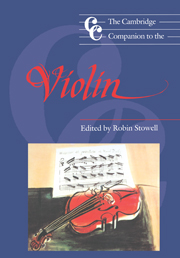Book contents
- Frontmatter
- 1 The violin and bow – origins and development
- 2 The physics of the violin
- 3 The violinists of the Baroque and Classical periods
- 4 The nineteenth-century bravura tradition
- 5 The twentieth century
- 6 The fundamentals of violin playing and teaching
- 7 Technique and performing practice
- 8 Aspects of contemporary technique (with comments about Cage, Feldman, Scelsi and Babbitt)
- 9 The concerto
- 10 The sonata
- 11 Other solo repertory
- 12 The violin as ensemble instrument
- 13 The pedagogical literature
- 14 The violin – instrument of four continents
- 15 The violin in jazz
- Appendix Principal violin treatises
- Glossary of technical terms
- Notes
- Select bibliography
- Index
5 - The twentieth century
Published online by Cambridge University Press: 28 September 2011
- Frontmatter
- 1 The violin and bow – origins and development
- 2 The physics of the violin
- 3 The violinists of the Baroque and Classical periods
- 4 The nineteenth-century bravura tradition
- 5 The twentieth century
- 6 The fundamentals of violin playing and teaching
- 7 Technique and performing practice
- 8 Aspects of contemporary technique (with comments about Cage, Feldman, Scelsi and Babbitt)
- 9 The concerto
- 10 The sonata
- 11 Other solo repertory
- 12 The violin as ensemble instrument
- 13 The pedagogical literature
- 14 The violin – instrument of four continents
- 15 The violin in jazz
- Appendix Principal violin treatises
- Glossary of technical terms
- Notes
- Select bibliography
- Index
Summary
At the turn of the century Joachim and Sarasate, two of the most prominent exponents of nineteenth-century violin playing, were still active. Highly regarded throughout their careers, the two figures represented opposite ideals: Joachim was the serious musician who probed the musical essence of a composition, and Sarasate the elegant violinist who played with a sleek but somewhat glib virtuosity. Renowned for the depth and spiritual quality of his interpretations, Joachim was venerated as the greatest interpreter of the German masterworks. He had first performed the Beethoven concerto as a thirteen-year-old under the baton of Mendelssohn and, as leader of the distinguished Joachim Quartet, did much to bring the Beethoven quartets to the public's attention. As a close friend of Brahms, Joachim not only championed many of the composer's works, but also inspired and advised Brahms, notably in the writing of his Violin Concerto. By contrast, Beethoven and Brahms were composers for whom Sarasate had little affinity. The violinist Albert Spalding recalled that ‘he played Beethoven with the perfumed polish of a courtier who doesn't quite believe what he is saying to Majesty’. As for the Brahms concerto, Sarasate unashamedly refused to perform the work, explaining, ‘Why should I stand there while the oboe has the only proper melody in the whole piece?’ It would be unfair, however, to dismiss Sarasate's achievement on the basis of his musical tastes. He was a unique personality, and had sufficient musical qualities to inspire a wide variety of composers to write works for him.
- Type
- Chapter
- Information
- The Cambridge Companion to the Violin , pp. 79 - 91Publisher: Cambridge University PressPrint publication year: 1992

